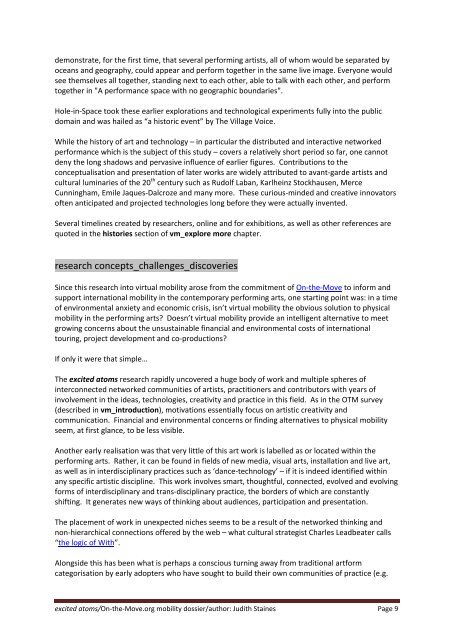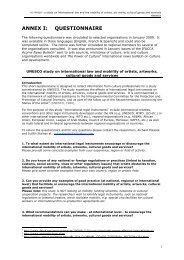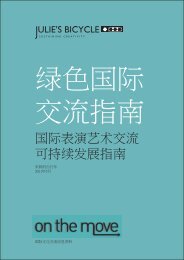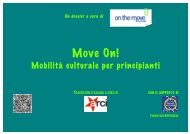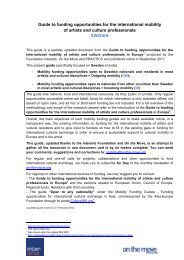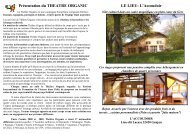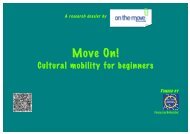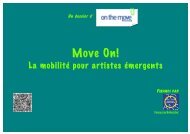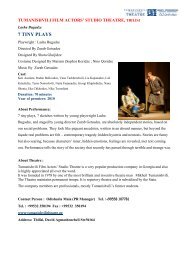DOWNLOAD Excited Atoms - On the Move
DOWNLOAD Excited Atoms - On the Move
DOWNLOAD Excited Atoms - On the Move
You also want an ePaper? Increase the reach of your titles
YUMPU automatically turns print PDFs into web optimized ePapers that Google loves.
demonstrate, for <strong>the</strong> first time, that several performing artists, all of whom would be separated by<br />
oceans and geography, could appear and perform toge<strong>the</strong>r in <strong>the</strong> same live image. Everyone would<br />
see <strong>the</strong>mselves all toge<strong>the</strong>r, standing next to each o<strong>the</strong>r, able to talk with each o<strong>the</strong>r, and perform<br />
toge<strong>the</strong>r in "A performance space with no geographic boundaries".<br />
Hole-in-Space took <strong>the</strong>se earlier explorations and technological experiments fully into <strong>the</strong> public<br />
domain and was hailed as “a historic event” by The Village Voice.<br />
While <strong>the</strong> history of art and technology – in particular <strong>the</strong> distributed and interactive networked<br />
performance which is <strong>the</strong> subject of this study – covers a relatively short period so far, one cannot<br />
deny <strong>the</strong> long shadows and pervasive influence of earlier figures. Contributions to <strong>the</strong><br />
conceptualisation and presentation of later works are widely attributed to avant-garde artists and<br />
cultural luminaries of <strong>the</strong> 20 th century such as Rudolf Laban, Karlheinz Stockhausen, Merce<br />
Cunningham, Emile Jaques-Dalcroze and many more. These curious-minded and creative innovators<br />
often anticipated and projected technologies long before <strong>the</strong>y were actually invented.<br />
Several timelines created by researchers, online and for exhibitions, as well as o<strong>the</strong>r references are<br />
quoted in <strong>the</strong> histories section of vm_explore more chapter.<br />
research concepts_challenges_discoveries<br />
Since this research into virtual mobility arose from <strong>the</strong> commitment of <strong>On</strong>-<strong>the</strong>-<strong>Move</strong> to inform and<br />
support international mobility in <strong>the</strong> contemporary performing arts, one starting point was: in a time<br />
of environmental anxiety and economic crisis, isn’t virtual mobility <strong>the</strong> obvious solution to physical<br />
mobility in <strong>the</strong> performing arts Doesn’t virtual mobility provide an intelligent alternative to meet<br />
growing concerns about <strong>the</strong> unsustainable financial and environmental costs of international<br />
touring, project development and co-productions<br />
If only it were that simple…<br />
The excited atoms research rapidly uncovered a huge body of work and multiple spheres of<br />
interconnected networked communities of artists, practitioners and contributors with years of<br />
involvement in <strong>the</strong> ideas, technologies, creativity and practice in this field. As in <strong>the</strong> OTM survey<br />
(described in vm_introduction), motivations essentially focus on artistic creativity and<br />
communication. Financial and environmental concerns or finding alternatives to physical mobility<br />
seem, at first glance, to be less visible.<br />
Ano<strong>the</strong>r early realisation was that very little of this art work is labelled as or located within <strong>the</strong><br />
performing arts. Ra<strong>the</strong>r, it can be found in fields of new media, visual arts, installation and live art,<br />
as well as in interdisciplinary practices such as ‘dance-technology’ – if it is indeed identified within<br />
any specific artistic discipline. This work involves smart, thoughtful, connected, evolved and evolving<br />
forms of interdisciplinary and trans-disciplinary practice, <strong>the</strong> borders of which are constantly<br />
shifting. It generates new ways of thinking about audiences, participation and presentation.<br />
The placement of work in unexpected niches seems to be a result of <strong>the</strong> networked thinking and<br />
non-hierarchical connections offered by <strong>the</strong> web – what cultural strategist Charles Leadbeater calls<br />
“<strong>the</strong> logic of With”.<br />
Alongside this has been what is perhaps a conscious turning away from traditional artform<br />
categorisation by early adopters who have sought to build <strong>the</strong>ir own communities of practice (e.g.<br />
excited atoms/<strong>On</strong>-<strong>the</strong>-<strong>Move</strong>.org mobility dossier/author: Judith Staines Page 9


